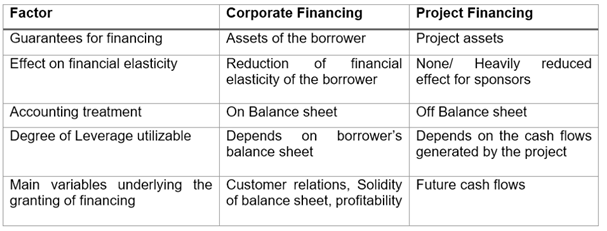Project finance is the financial analysis of the complete life-cycle of a project. Typically, a cost-benefit analysis (CBA) is used to determine if the economic benefits of a project are larger than the economic costs. The analysis is particularly important for long-term projects of Growth Capital Expenditure. The first step of the analysis is to determine the Financial Structuring of the Project, a mixture of Debt & Equity, that will be used to finance the project. Then, identify and value the economic benefits of the project and determine if the benefits outweigh the costs.

Breakdown of the Definition
Now let us break down each of the components of this definition to get a detailed understanding of what it incorporates:
1) Financing of long-term infrastructure, industrial projects, and public services
Project finance is generally used in oil extraction, power production, and infrastructure sectors. These are the most appropriate sectors for developing this structured financing technique, as they have low technological risk, a reasonably predictable market, and the possibility of selling to a single buyer or a few large buyers based on multi-year contracts (e.g. take-or-pay contracts).
2) Non-recourse/limited recourse financial structure
Project finance is the structured financing of a specific economic entity A Special Purpose Vehicle (SPV) - is created by the sponsors using equity or debt. The lender considers the cash flow generated from this entity as the major source of loan reimbursement.
Hence, if the borrower has a debt default, the debt-issuer has the right to seize the assets of the said SPV. However, they do not have the right to any further assets that are not part of the SPV, even if the liquidating assets of the SPV are not sufficient to cover the value owed due to default.
3) Payment from Cash flow generated by the project
I am drawing a practical Example of (YIAPL-Jewar In Uttar Pradesh) the new Airport Project coming up near NCR, This project is being developed as a public-private partnership between Zurich Airport and Uttar Pradesh government. Zurich Airport is investing Rs 5,700 crore for phase I and has tied up around Rs 3,725 crore in debt from the State Bank of India for the project.
Cash flows generated by the SPV must be sufficient to cover payments for operating costs and to service the debt in terms of capital repayment and interest. Because the priority use of cash flow is to fund operating costs and to service the debt, only residual funds after the latter are covered can be used to pay dividends to sponsors undertaking the project.
Why do Sponsors Use Project Finance?
A sponsor (the entity requiring finance to fund projects) can choose to finance a new project using two alternatives:
- The new initiative is financed on the balance sheet (corporate financing)
- The new project is incorporated into a newly created economic entity, the SPV, and financed off-balance sheet (project financing)
1. Corporate Finance
Alternative 1 means that the sponsors use all the assets and cash flows from the existing firm to guarantee additional credit provided by lenders. If the project is not successful, then all the remaining assets and cash flows can serve as a source of repayment for all the creditors (old and new) of the combined entity (existing firm plus new project).
2. Project Finance
Alternative 2 means that the new project and the existing firm live two separate lives. If the project is not successful, project creditors have no (or very limited) claim on the sponsoring firm’s assets and cash flows. The existing shareholders then benefit from the separate incorporation of the new project into an SPV.
How is Project Finance Different from Corporate Finance?
Now that we have a basic understanding of what project finance means, let us understand how it differs from corporate finance. The table below outlines important differences between the two types of financing that need to be taken into account.

Who are the Sponsors of Project Finance?
By participating in a project finance venture, each project sponsor pursues a clear objective, which differs depending on the type of sponsor. In brief, four types of sponsors are very often involved in such transactions:
- Industrial sponsors - They see the initiative as upstream and downstream integrated or in some way as linked to their core business
- Public sponsors - Central or local government, municipalities, and municipalized companies whose aims center on social welfare
- Contractor sponsors - Who develop, build, or run plants and are interested in participating in the initiative by providing equity and or subordinated debt
- Financial sponsors / investors - Invest with a motive to invest capital in high-profit deals. They have a high propensity for risk and seek a substantial return on investments
Key Features of Project Financing
Since a project deals with huge amounts of funds, it is important that you learn about this structured financial scheme. Below mentioned are the key features of Project Financing:
- Capital Intensive Financing Scheme: Project Financing is ideal for ventures requiring huge amounts of equity and debt, and is usually implemented in developing countries as it leads to the economic growth of the country. Being more expensive than corporate loans, this financing scheme drives costs higher while reducing liquidity. Additionally, the projects under this plan commonly carry Emerging Market Risk and Political Risk. To ensure the project is against these risks, the project also has to pay expensive premiums.
- Risk Allocation: Under this financial plan, some of the risks associated with the project are shifted towards the lender. Therefore, sponsors prefer to avail this financing scheme since it helps them mitigate some of the risks. On the other hand, lenders can receive a better credit margin with Project Financing.
- Multiple Participants Applicable: As Project Financing often concerns a large-scale project, it is possible to allocate numerous parties in the project to take care of its various aspects. This helps in the seamless operation of the entire process.
- Asset Ownership is decided at the Completion of Project: The Special Purpose Vehicle is responsible for an overview of the proceedings of the project while monitoring the assets related to the project. Once the project is completed, the project ownership goes to the concerned entity as determined by the terms of the loan.
- Zero or Limited Recourse Financing Solution: Since the borrower does not have ownership of the project until its completion, the lenders do not have to waste time or resources evaluating the assets and credibility of the borrower. Instead, the lender can focus on the feasibility of the project. The financial services company can opt for limited recourse from the sponsors if it deduces that the project might not be able to generate enough cash flow to repay the loan after completion.
- Loan Repayment with Project Cash Flow: According to the terms of the loan in Project Financing, the excess cash flow received by the project should be used to pay off the outstanding debt received by the borrower. As the debt is gradually paid off, this will reduce the risk exposure of financial services companies.
- Better Tax Treatment: If Project Financing is implemented, the project and/or the sponsors can receive the benefit of better tax treatment. Therefore, this structured financing solution is preferred by sponsors to receive funds for long-term projects.
- Sponsor Credit Has No Impact on Project: While this long-term financing plan maximizes the leverage of a project, it also ensures that the credit standings of the sponsor have no negative impact on the project. Due to this reason, the credit risk of the project is often better than the credit standings of the sponsor
What Are the Various Stages of Project Financing?
Pre-Financing Stage
- Identification of the Project Plan - This process includes identifying the strategic plan of the project and analyzing whether its plausible or not. In order to ensure that the project plan is in line with the goals of the financial services company, it is crucial for the lender to perform this step.
- Recognizing and Minimising the Risk - Risk management is one of the key steps that should be focused on before the project financing venture begins. Before investing, the lender has every right to check if the project has enough available resources to avoid any future risks.
- Checking Project Feasibility - Before a lender decides to invest in a project, it is important to check if the concerned project is financially and technically feasible by analyzing all the associated factors.
Detailed Project Reports (DPRs) are the outputs of the planning and design phase of a project. DPR is a very detailed and elaborate plan for a project indicating the overall program, different roles, and responsibilities, activities, and resources required for the project.
Financing Stage
Being the most crucial part of Project Financing, this step is further sub-categorized into the following:
- Arrangement of Finances - In order to take care of the finances related to the project, the sponsor needs to acquire equity or loan from a financial services organization whose goals are aligned to that of the project
- Loan or Equity Negotiation - During this step, the borrower and lender negotiate the loan amount and come to a unanimous decision regarding the same.
- Documentation and Verification - In this step, the terms of the loan are mutually decided and documented keeping the policies of the project in mind.
- Payment - Once the loan documentation is done, the borrower receives the funds as agreed previously to carry out the operations of the project.
Post-Financing Stage
- Timely Project Monitoring - As the project commences, it is the job of the project manager to monitor the project at regular intervals.
- Project Closure - This step signifies the end of the project.
- Loan Repayment - After the project has ended, it is imperative to keep track of the cash flow from its operations as these funds will be, then, utilized to repay the loan taken to finance the project.
Normally the bankers of the projects get an assignment in their favour so that all receipts of the contractors come into their account with little scope of diversion of funds. The contractors based on their activity of the project get a good banking facility by way of fund-based facilities and non-fund-based facilities. In such PPP projects Once the project is over the revenue generated by the project has to come into this same account because of the earlier lending facilities for the mega projects, it’s like they have a first charge on all the revenues of the project. Normally infrastructure projects require a huge financial commitment and bankers have an uphill task to finance such mega projects only banks with adequate capital adequacy can finance such projects








 CAclubindia
CAclubindia
